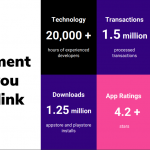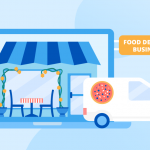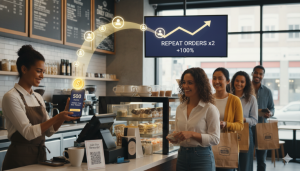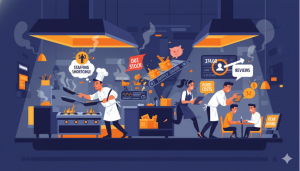Online food ordering and delivery has witnessed an unprecedented surge, especially in the post-COVID environment. The world in general and Saudi Arabia, in particular, witnessed unprecedented growth in the online food delivery and ordering industry.
Earlier, millennials and tech-savvy people had already acquainted themselves with online food ordering and delivery mechanisms that offered multiple benefits. Apart from being under the growing umbrella of “quick commerce” and offering mobility comfort, post-COVID lifestyle changes and lengthy durations of lockdowns across the globe proved to be a tipping point for the food conveyance business as it prompted everyone to use online food delivery and ordering applications and web portals.
Moreover, the orientation of the global economy towards a “cashless economy”, innovations in the financial industry with safer and safer mechanisms of making online transactions have encouraged “cloud kitchens” and online food ordering platforms to emerge across the globe.
In the context of Saudi Arabia, and its food conveyance industry is no different in terms of growth. According to research, the online food delivery industry in Saudi Arabia is expected to grow and register an annual revenue of USD 2BN by 2023. Therefore, it is evident that the online food ordering and delivery industry is destined to grow as a market. In fact, the market is expected to grow from $107.44 billion in 2019 to around $154.34 billion in 2023.
In such a growth-oriented competitive environment, online food ordering and delivery mechanisms then become a strategic driver for the overall food and restaurant industry, where consumer experience and understanding consumer behavioral science becomes key factors that will grant a competitive edge to investors and market players. Those who fail to understand this evolving industry and its linkages to various dimensions of overall consumer experience will be pushed out of the market.
The online food delivery platforms represent 8% of the total foodservice market, and it is estimated that the penetration rate will double within five years. Interestingly, we also witnessed other companies in the business of logistics and transport integrating their existing fleet into the online food delivery mechanism.
The aggregator food delivery startups
At present, broadly speaking there are two major models of online food delivery startups. The first broad model is of those called “aggregators’ ‘ like Swiggy, and Food Panda.
Aggregators build on the traditional model for food delivery, offering access to multiple restaurants through a single online portal. The aggregators collect a fixed margin of the order, which is paid by the restaurant, and the restaurant handles the actual delivery. In some cases, aggregators charge on the number of clicks online by the customer and they also provide a marketing channel for these restaurants by offering various deals and discounts to customers on a single platform. According to estimates, online ordering platforms and services are now generating about 70% of restaurant orders on average. However, besides “aggregating” these start-ups have little to offer, hence to some they are no less than alligators, charging both ends of the online food supply chain, meanwhile hoarding customer data which then is at times sold to open sources in the market for other marketing purposes.
Branded food ordering applications like Blink enable restaurants to reach their target market with their own website/app.
The other model in competition to traditional aggregators is that of branded food ordering applications like Blink which provide a platform for restaurants to reach their target audience and customers. Unlike aggregators who like alligators’ binge on Data, this model is more smart and intelligent.
They not only aggregate data but provide smart analysis and insights to restaurants so that they can understand their customer base and their behavioral patterns so as to better design their product and provide targeted marketing deals.
Blink, unlike Zomato and other aggregators, is a one-stop-shop for different services to restaurant owners. It offers a whole spectrum of services based on data analytics, consumer spending patterns, their choice patterns and in addition, offers different ways and means of marketing, which based on real-time data helps the restaurants to be targeted in their approach while satisfying consumer demands. Moreover, it has a better understanding of the market trends and opportunities compared to a single restaurant or platform, which is passed onto its partner restaurants.
From platform to customer delivery model such as this, provides restaurants with capital leverage which could have been tied to maintaining and supervising delivery fleets. Under this mechanism, these fleets are largely controlled and monitored by the platform, giving a strategic edge and opportunity to restaurants to focus on their product only.
[INSERT_ELEMENTOR id=”2061″]
The 8 Tips to Grow your Food Delivery Business in Saudi Arabia
The following are some tips for online food delivery businesses in Saudi Arabia in particular and the world in general in order to grow their business. These recommendations are designed keeping in mind Saudi online food delivery and ordering industry at the forefront and general market trends across the globe as background context.
- Use Technology to Accept Orders
As mentioned earlier, technology is proving to be a need in our daily lives rather than being a luxury a few years ago.
Especially in the post-COVID environment, technology in the food ordering and delivery industry has proven to grow at an exponential rate. For example, Blink offers customers various discount deals and marketing offers on a single platform. It’s a smart and intelligent software that not only registers orders from customers but also keeps a track of their buying patterns, choices, and combinations of chosen products. This not only helps restaurants in better understanding their customer but also helps them in designing better, more popular marketing offers. Each order given by the customer on Blink is critically monitored and supervised by the intelligent software of Blink that provides back-end support to restaurants. This way technology helps save restaurant human resources required for critical decision making. Technology helps restaurants maintain call logs and can better, effectively maintain their point of sales and the entire process of the delivery mechanism.
[INSERT_ELEMENTOR id=”2061″]
- Share the Secret Recipe of your Popular Dishes
Trade secrets are no more secrets in this age so why should we be insecure of others. In these times it’s better to be confident of your ways and means of conducting business as consumers are not buying a particular dish or item, they are after the experience they get. So, in order to give customers a better experience and maintain a relationship of trust and mutual benefit, it is important that you share your recipes with them. Some restaurants in order to encourage their customers and in order to develop a cordial relationship have also begun to organize visits to kitchens.
Open kitchens are now common where customers can see live in real-time their food being prepared as restaurants tend to promote hygiene through such marketing stunts. By sharing recipes, you also tend to publicly trademark your dish in their mindset which helps restaurants to keep competitors out from capturing market share as your recipe becomes an authentic symbol of that certain dish. For example, we have seen Nandos sharing their sauce and recipes with customers and by doing so they have registered Peri-Peri chicken as something of their own innovation and synonymous to their restaurant name.
- Take Reviews Online
Another way to engage customers and to give their feedback importance is through taking online reviews and feedback. This not only provides restaurants with valuable customer insights without any extra resource being spent on marketing but also restores customer/client relationships with the business, giving them more ownership and voice in the product mix and its quality. Another important aspect is that with more growth in the online food ordering business, customers have tended to take online reviews more seriously when it comes to deciding their order. This way they can compare and contrast different dishes and value meals.
- Offer Free Food to Foodie Influencer
Social media influencers with a following of millions are growing more and more critical in marketing campaigns by brands. A social media influencer not only provides a marketer eyeball attached to his social media accounts but also maintains certain credibility in public which is then shared with the brand he promotes. This way restaurants can invite social media influencers to dine in their restaurants, try the best and recommended dishes, and then give their feedback, which if favorable will prompt millions to try that similar dish from that particular restaurant.
- Improve the Food Quality/Service
However much you spend on marketing, eventually it is the quality of your food and service that will keep a restaurant afloat. Marketing campaigns can bring a customer for once, but bringing them recurring times will be dependent on your quality of food and service. It is important to notice that food quality with poor service is also going to take you nowhere, hence it is the ultimate mix of both food quality and the service that will ultimately help in retaining a customer.
- Optimize your menu
For restaurants it is very important to offer the right mix of products/dishes, offering the best possible combination of meals to the customers. In this regard, it is the ultimate customer experience that matters the most, and Blink provides these critical insights to their clients. By using smart and intelligent algorithms Blink offers critical data analytics to their clients which help them in gauging customer experience and preferences. Therefore, it becomes of great value for the restaurants to optimize their menu based on customer feedback and online reviews and by also using smart research tools to better position their menu offerings than competitors.
- Refresh your food photos and descriptions
Audio and visual description according to research has a greater impact on the person, therefore it becomes very pertinent for the restaurants to use audio/visual medium in order to promote their menu and their food. It is estimated that with high-quality photos and videos restaurants sales are expected to rise by 30 percent.
- Take advantage of social media
Social media is becoming more and more significant in terms of user engagement. As mentioned earlier, it is important to use social media influencers for promotions. Similarly, it is very pertinent for a restaurant to keep an updated social media presence, engage people through audio/visual means. Social media is also cheaper as compared to mainstream electronic media. It also offers critical audience insights to those who wish to take advantage of it in marketing. Saudi Arabia is expected to have 88 percent smartphone penetration. With this high percentage and usage of social media on phones, it directly becomes a key driver for any marketing campaign.
[INSERT_ELEMENTOR id=”2061″]
Conclusion
The online food delivery and ordering mechanism in Saudi Arabia and the world, in general, is on a rise. In a Post-COVID environment that has triggered certain lifestyle changes, the food conveyance business is certainly going to develop into a market with multiple linkages to the overall consumption-driven, cashless economy. The article has recommended smart ways of growing in the domain of the online food delivery business. Certainly, every start-up or every other aggregator would have to differentiate itself by offering new services and conveyance to the customer while overall enriching their customer experience. However, Blink has more to offer, not only to the customer experience but also to the restaurants by helping them in making strategic decision making in light of data-driven, evidence-based analytics. Blink is the future for online delivery and ordering business as it has more to offer than take.
Related Articles:
 What is a Point of Sale System and how Does It Work?
What is a Point of Sale System and how Does It Work?
 Our Guide to the Best Restaurant Management Software & What to Consider
Our Guide to the Best Restaurant Management Software & What to Consider
 Everything You Need to Know About Starting an Online Food Delivery Business
Everything You Need to Know About Starting an Online Food Delivery Business
 Get to Know the 9 Best Pizza Places in Islamabad
Get to Know the 9 Best Pizza Places in Islamabad
 Which Restaurant Management System to opt-for in Saudi Arabia
Which Restaurant Management System to opt-for in Saudi Arabia









